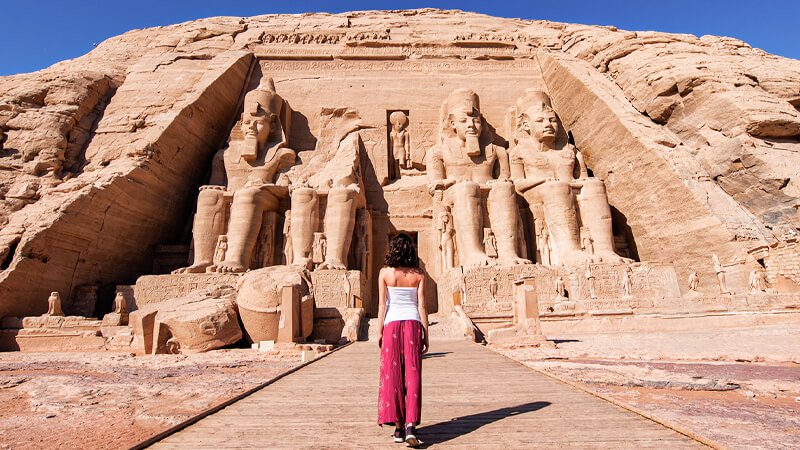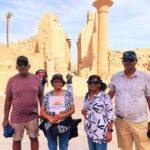Egypt, a land steeped in history and mystique, beckons travelers with its remarkable landmarks that testify to its ancient civilization. From the grandeur of the Giza Pyramids to the Nile River’s tranquility, landmarks in Egypt offer a glimpse into its storied past. In this guide, we’ll take you on a virtual journey through the most iconic 15 Landmarks in Egypt, offering insights, historical context, and practical tips for your adventure.
Top 15 Landmarks in Egypt You Must See

Egypt is a treasure trove of landmarks that tell the tale of an ancient civilization’s triumphs and struggles. These landmarks symbolize Egypt’s cultural and architectural prowess, attracting millions of visitors worldwide.
1. The Pyramids of Giza: A Marvel of Ancient Engineering
All exploration of Egypt’s landmarks is complete with marveling at the Pyramids of Giza. The Great Pyramid, built as a tomb for Pharaoh Khufu, showcases unparalleled engineering precision. Standing against the desert backdrop, it has intrigued historians and architects for centuries, leaving us in awe of the ingenuity of ancient Egyptians.
2. The Sphinx: Guardian of Secrets
Adjacent to the Pyramids stands the enigmatic Sphinx, a mythical creature with a lion’s body and a pharaoh’s head. Carved from limestone, it is believed to represent Pharaoh Khafre. The Sphinx’s stoic gaze seems to hold the secrets of time, inviting speculation and wonder.
3. Grand Egyptian Museum: The Future of Landmarks in Egypt
End your cultural journey near Giza at the Grand Egyptian Museum (GEM) — a modern marvel and soon-to-be one of the most visited Egyptian attractions. Located near the Pyramids, this landmark in Egypt will display over 100,000 artifacts, including the full collection of Tutankhamun’s treasures. With interactive exhibits and spectacular architecture, the GEM represents a new era of Egypt landmarks, offering visitors an unforgettable way to experience Egypt’s past while looking toward its future.
4. The Egyptian Museum: A Trove of Treasures
The Egyptian Museum, situated in Cairo’s Tahrir Square, is one of the most iconic landmarks in Egypt and a must-visit for history enthusiasts. This landmark in Egypt houses over 120,000 artifacts showcasing the fascinating history of ancient Egypt. Inside, visitors can explore royal mummies, intricately carved statues, papyri, jewelry, and artifacts from daily life that span from the Predynastic period to the Greco-Roman era. Its grand halls and detailed exhibits make it one of the most famous landmarks in Egypt, offering travelers an unforgettable journey through the country’s extraordinary past.
5. Coptic Cairo: A Spiritual Landmark in Egypt
Begin your exploration of Egypt landmarks in Coptic Cairo, a historic neighborhood that reveals Egypt’s Christian past. This area is home to some of the oldest churches in the world, including the Hanging Church, built above the Roman fortress of Babylon. Nearby, Saint Sergius and Bacchus Church is believed to have sheltered the Holy Family during their time in Egypt. The Coptic Museum houses rare manuscripts, relics, and art pieces that trace Christianity’s evolution in Egypt, while the Ben Ezra Synagogue highlights the neighborhood’s religious diversity. Walking through Coptic Cairo feels like stepping into a living museum, making it one of the most meaningful landmarks in Egypt for history lovers.
6. Islamic Cairo: A Hub of Famous Landmarks in Egypt
From Coptic Cairo, head to Islamic Cairo, a UNESCO World Heritage Site brimming with some of the most famous landmarks in Egypt. The area is dominated by the Citadel of Saladin, home to the stunning Mosque of Muhammad Ali, an architectural Egypt landmark offering breathtaking views of the city. Stroll along Al-Muizz Street, where centuries-old mosques, palaces, and fountains transport you back to the medieval Islamic era. Key Egyptian landmarks here include Sultan Hassan Mosque, Al-Rifa’i Mosque, and the historic Ibn Tulun Mosque. End your visit at Khan El Khalili Bazaar, one of the most colorful and lively landmarks Egypt has to offer, perfect for shopping and soaking in Cairo’s vibrant culture.
7. Khan El Khalili: Bustling Bazaar Experience
Imagine Cairo’s vibrant culture at Khan El Khalili, a historic market brimming with colors, scents, and sounds. From intricate crafts to aromatic spices, this bazaar captures the essence of Egypt’s bustling trade history.

8. Luxor Temple: Where Past Meets Present
In the heart of Luxor lies the Luxor Temple, a majestic complex dedicated to Amun-Ra, Mut, and Khonsu. As the sun sets, the temple’s columns and statues are bathed in a warm golden glow, creating a surreal atmosphere that transports visitors to the time of pharaohs and gods.
9. Karnak Temple: A Monumental Tribute to Thebes
Just north of Luxor, the Karnak Temple Complex stands as one of the largest religious sites in the world. Its towering columns, intricate hieroglyphics, and sacred pools vividly depict ancient rituals and spiritual devotion.
10. Valley of the Kings: Tombs of the Pharaohs
Hidden beneath the rocky terrain of Luxor’s west bank lies the Valley of the Kings. This cemetery is home to the tombs of numerous pharaohs, including Tutankhamun. Each grave is a testament to ancient Egypt’s elaborate burial practices and beliefs.
11. Abu Simbel Temples: Carved in Stone
Traveling south, you’ll encounter the awe-inspiring Abu Simbel Temples. Carved into the cliffs during the reign of Ramses II, these temples showcase colossal statues and intricate reliefs that narrate the pharaoh’s victories and deification.

12. Philae Temple: An Ancient Egyptian Landmark
No trip to Aswan is complete without visiting Philae Temple, one of the most breathtaking landmarks in Egypt. Dedicated to the goddess Isis, this temple was saved from flooding during the construction of the Aswan High Dam and relocated to Agilkia Island — a remarkable feat that preserved this Egypt landmark for future generations. With its elegant courtyards, detailed reliefs, and the iconic Trajan’s Kiosk, Philae is a top choice among travelers seeking famous landmarks in Egypt that combine history, architecture, and stunning natural scenery.
13. Kom Ombo and Edfu Temples
Kom Ombo and Edfu are two of the most remarkable landmarks in Egypt. Kom Ombo Temple is unique as it honors two gods—Sobek, the crocodile god, and Horus, the falcon god—featuring twin halls and a fascinating Crocodile Museum. Edfu Temple, one of the best-preserved Egyptian landmarks, is dedicated to Horus and showcases towering pylons and detailed carvings that reveal ancient Ptolemaic history. These Egypt landmarks are must-see stops on any Nile cruise.
14. Nubian Village: A Living Landmark in Egypt
Travel south to Aswan to explore a landmark in Egypt that is full of life and color — the Nubian Village. Known for its brightly painted houses and warm hospitality, this community is a cultural highlight among Egyptian landmarks. Many tours include a scenic boat ride on the Nile to reach the village, where you can visit local markets, learn about Nubian traditions, and even share tea with a local family. Experiencing a Nubian village is one of the most authentic ways to connect with the living heritage of Egypt landmarks beyond the temples and tombs.

15. The Nile River: Lifeblood of Egypt
While not a traditional structure, the Nile River is one of the most iconic landmarks in Egypt and the reason this ancient civilization flourished. Its fertile banks have sustained life for millennia, shaping Egypt’s history, culture, and economy. Often called the lifeblood of Egypt, the Nile is more than a river—it is a living connection to the country’s past. Today, travelers can embark on a serene Nile cruise, gliding past lush green fields, timeless temples, and traditional villages. These journeys offer a front-row seat to the landscapes that inspired poets, artists, and pharaohs for centuries. Watching the sunrise or sunset over the Nile remains one of the most unforgettable experiences among all Egyptian landmarks.
Conclusion
Exploring the landmarks in Egypt is like stepping back in time, where the ancient and modern seamlessly blend. From the monumental pyramids to the tranquil Nile River, these landmarks narrate the story of a civilization that has left an indelible mark on history. Whether you’re a history enthusiast, an architecture fan, or a curious traveler, landmarks in Egypt promise a journey filled with wonder and discovery.
FAQs About Landmarks in Egypt
- What is a famous landmark found in Egypt?
A famous landmark in Egypt is the Great Pyramid of Giza, part of the Giza Pyramid Complex and one of the most visited Egypt landmarks. - Which of the 7 Wonders is located in Egypt?
Egypt is home to the Great Pyramid of Giza, the last surviving wonder of the Seven Wonders of the Ancient World and a top Egyptian landmark. - What are the modern landmarks of Egypt?
Modern landmarks in Egypt include the Cairo Tower, Bibliotheca Alexandrina, the Grand Egyptian Museum, and the Aswan High Dam. - What are the most famous places in Egypt?
The most famous places in Egypt are the Pyramids of Giza, Luxor Temple, Valley of the Kings, Abu Simbel, and the Nile River. - What is the most unforgettable place in Egypt?
The Nile River is often called the most unforgettable place in Egypt, offering scenic cruises past temples, tombs, and famous Egyptian landmarks.




